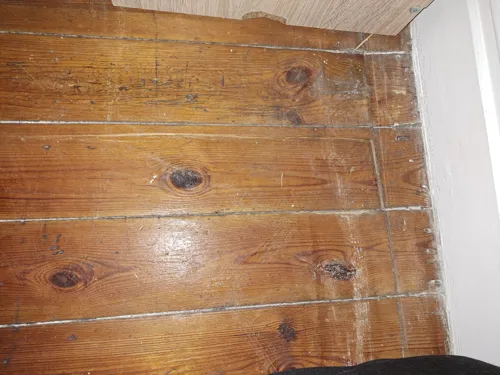Are you worried about water damage on wooden floors and how it affects your beloved hardwood or parquet? If you’ve noticed warped boards, dark water stains, or lingering musty odours, you are not alone. In this article, you will learn why water-related damage happens, how to repair it, and how to safeguard your floors for good.
Common causes of water damage on wooden floors
Wooden floors are prone to floor discoloration and damage due to everyday spills and underlying moisture issues. Below are some common causes you should watch out for:
- Leaks or pipe bursts: A hidden plumbing leak or sudden burst can cause water seepage beneath your wooden floor. Often, the first visible signs are warped floorboards or discolored patches.
- High humidity and poor ventilation: Moisture naturally travels upward, including through your flooring. In humid areas with little air circulation, moisture exposure can accumulate and result in mold growth signs and wood floor stains.
- Spills and incorrect cleaning methods: Using excessive water during mopping (or failing to dry spills immediately) can lead to persistent dampness, especially if your floor’s finish is worn.
- Roof or structural leaks: Sometimes, the water comes from above – a damaged roof, windows, or walls can drip, trickling into the wooden floor structure below.
When these factors aren’t addressed early on, minor floor discoloration may escalate into full-blown moisture issues that significantly weaken your flooring.

Potential consequences if you ignore water damage on wooden floors
Leaving water damage unattended can cause bigger headaches down the road. Here’s why:
- Ongoing mold and mildew growth: Once fungus takes hold, it can spread rapidly beneath the surface, compromising your indoor air quality.
- Increased structural damage: Long-term moisture can weaken not only the wooden flooring itself but also supporting beams or subfloors.
- Costly hardwood floor repairs later: Delaying solutions often means more extensive (and expensive) fixes, such as total floor replacement.
- Unpleasant odours: Prolonged dampness produces strong musty smells that linger in your home and can be difficult to eliminate.
Staying on top of maintenance saves your floors, your wallet, and your precious time. If you need real help from reliable professionals, consider requesting a free quote to get started.

Effective solutions for water damage on wooden floors
1. Immediate DIY clean-up and drying
If you spot fresh water on the floor, act quickly. Here’s what you can do:
- Gather materials: Microfibre cloths, a wet/dry vacuum, and a fan or dehumidifier.
- Remove standing water: Carefully use towels or a wet/dry vacuum to collect excess water. Ensure the floor surface is completely dry.
- Increase ventilation: Turn on fans and open windows to promote air flow. Use a dehumidifier to speed up drying and reduce moisture in the area.
Potential pitfall: If moisture has already soaked through or you suspect an underlying leak, contact a specialist for a thorough inspection.
2. Spot-treat minor wood floor stains
For light floor discoloration or minor wood floor stains:
- Materials: Fine-grit sandpaper (180–220), mild wood cleaner, and a clean cloth.
- Light sanding: Gently sand the stained area to remove the top layer of discolouration.
- Clean and dry: Wipe away dust with the cloth, apply the wood cleaner, and let the spot dry thoroughly.
- Refinish: Apply a matching finish or protective coating, abiding by the product’s instructions.
Potential pitfall: Over-sanding can cause dips or uneven sections in your floor. Sand carefully to avoid creating further damage.
If you find that stains return or the discolouration is getting worse, it might indicate a deeper moisture issue. Requesting help from a professional can help you catch small problems before they get bigger.
3. Professional sanding and refinishing
When you have pronounced water damage or a larger area of warped floorboards, professional hardwood floor repairs might be your best bet. Here’s what this process typically involves:
- Assessment and preparation: A skilled pro checks your floor’s moisture levels, replaces severely damaged boards, and prepares the entire area for work.
- Sanding: They use specialised equipment to remove the old finish and smooth any imperfections. This ensures a uniform surface for stain or sealant.
- Refinishing: Next, they apply stains or sealants that restore colour and protect your floor from future moisture issues.
- Final sealing: After the finish dries, a sealant or protective topcoat is added. This helps your newly restored floor resist everyday wear and tear.
Benefits of professional help: Faster completion, high-grade materials, and a warranty for better peace of mind.

When to call a professional
- The water damage extends across a large area or has compromised the structural integrity.
- Extensive mold growth signs or strong lingering smells indicate a deeper situation.
- You suspect the moisture source includes hidden leaks or serious subfloor damage.
- You prefer a lasting, expertly finished look without guesswork.
A fresh start for your floors
Saving your wooden flooring from water damage doesn’t have to be complicated. A prompt response and the right resources can make all the difference. If you’re dealing with a stubborn leak or severe moisture exposure, consider reaching out for professional floor restoration help—restore your home’s beauty and enjoy peace of mind.







